‘Worst daddy’
Comedian David Cross
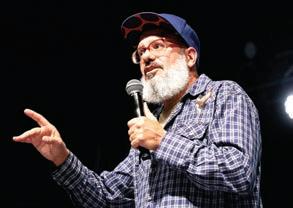
Hollywood,

Comedian David Cross

Hollywood,
The years-long battle over noise complaints at the Laberge Shooting Range, a private, openair shooting range located on a 287-acre family farm on Lime Kiln Road, has again resurfaced in Charlotte, this time with some members of the town selectboard considering the creation of a noise ordinance to avoid the onslaught of an “expensive legal issue” with neighboring residents.
“We understand that there have been some changes in the amount of noise and the guns that are being used and that brings it back in front of us,” selectboard chair Jim Faulkner said Monday. “This issue has been in front of the selectboard in the past, and it’s ramping up a little bit again. There’s a concern for a lot of the neighbors about the noise and there might be some legal suits in process that will affect the town considerably.”
Since as far back as 1994, the
shooting range, part of a large parcel of land owned by Laberge and Sons, Inc., has been the recipient of a slew of resident-led backlash over noise complaints, with the most recent court battle taking place in 2015, when a group of anonymous neighbors formed the Firing Range Neighborhood Group and filed a request with the District 4 Environmental Commission to determine whether or not the firing range is a development that should come under Act 250 jurisdiction.
The Vermont Supreme Court ruled three years later, in August 2018, that the range was not subject to Act 250 jurisdiction and therefore could continue to operate without state regulation.
But, Faulkner said at Monday’s meeting, “This group is not willing to just accept that.”
Last year, the selectboard authorized Faulkner and select-
See NOISE on page 3
As kids in the Champlain Valley School District begin their academic year this week, the school district’s administrators and board members are staring down what will be a challenging five years.

The district’s school buildings are aging and will need millions
of dollars in renovations. Federal Covid-19 relief funds are soon ending — funding that has paid for more than a dozen school counselors, social workers, interventionists, and other positions within the district. And updates to Vermont’s education formula means the district will have to adjust to these factors while raising taxes or cutting programs.
Those three converging factors
bearing down on the district were laid out during a school board meeting last week, where officials said the district will be implementing new measures to try and limit any new spending — including requiring offsetting reductions for any new proposed expenses.
“We’re going to have to make some really difficult decisions together,” chief operations officer Gary Marckres said.
Vermont’s new education formula, signed into law last year, corrects what researchers at University of Vermont and Rutgers University showed was an insufficient pupil weighting system for low-income students or non-English speaking students. The new formula tries to correct that, but because of the shift, several districts that have historically benefitted from the weighting —
Champlain Valley, South Burlington, Essex, and Mount Mansfield Unified Union among them — are now facing dwindling student counts, meaning those distrcits will eventually have to start raising taxes or cutting spending to fill in the gap.
Because of this, the Champlain
See SCHOOL on page 9
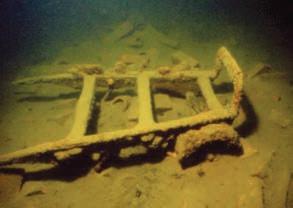
 COREY MCDONALD STAFF WRITER
COREY MCDONALD STAFF WRITER
Davis Cross has won numerous awards, but this one might be his most prolific of all: Worst Daddy in the World.
His full biography is too long to list. An Emmy Award winner and two-time Grammy Award nominee, Cross has had a prolific, decades-long career as an actor and writer. He’s appeared in dozens of TV and movie productions — the sketch comedy “Mr. Show” with Bob Odenkirk, and “The Ben Stiller Show;” he voiced roles in Boots Riley’s film, “Sorry To Bother You,” and was in Steven Spielberg’s “The Post;” and, of course, he starred as Dr. Tobias Fünke in Netflix’s “Arrested Development,” for which he was twice-nominated as part of the ensemble cast for a Screen Actors Guild Award and won.
He’s currently starring in the Julia Louis-Dreyfus film “You Hurt My Feelings,” the FX series “Justified: City Primeval,” and he will join the cast of the Netflix series “The Umbrella Academy” for its fourth and final season.
But it was standup where Cross first began his career. Named one of the top 100 Stand-Up Comedians of all time, he’s back on tour, celebrating his new status as “Worst Daddy in the World.”
Cross’s 2023 theatre tour will visit 66 cities across North America Ireland and the U.K. For every ticket sold, Cross will donate $2 to The Innocence Project, an organization working to exonerate individuals who have been wrongly convicted.
As a father of 7-year-old daughter, Cross is doing things a little differently by breaking his tour up into segments, flying back
and forth from his home to his touring cities so he can spend time with his family.
South Burlington will be his first show back for the fall leg of his tour. The Other Paper interviewed Cross in the lead up to his Sept. 6 leg of the tour at Higher Ground
This interview has been edited for length and clarity.
I’d like to offer an early
welcome to Vermont, although according to my Google sleuthing it looks like you’ve been around here before.
Oh, many times.
Are you excited to be back?
I’ve outgrown some of my flannels, so yes.
You’ve been to dozens of cities on this tour already, and throughout your career. I’m sure after doing this for as long as you have there’s some familiarity with each city or state. What sort of thoughts come to mind when you head up to Vermont?
I was literally just there — not in Burlington but in Jamaica about two weeks ago with the family. I love Vermont. I spent nine years and change in Boston, so I was up there a lot, mostly doing standup but also just skiing.
I love Burlington. My wife and I honeymooned there and would go up annually and go eat at Hen of the Wood and, you know, just go on little adventures and hikes and things like that.
So, congratulations on your recent accolade as “Worst Daddy in the World,” which I read was selected specifically by your daughter.
I mean, you know, she submitted me, and we still have to wait for the results. It’s done out of Sri Lanka. It’s a global thing. We’ll
see. But I’m representing the northern hemisphere. Of course. Well good luck with that. You’ve said in previous articles that your show is not all about your daughter — Not even close.
But I’m interested — one of your last specials you do talk about her and just that experience. Has raising a child given a boost to your creativity for writing jokes on the stage or writing material for TV or movies?
I wouldn’t say a boost. It just opens up a new experience to talk about and to cull from. It’s not like I had a kid and I was rushing to the computer like, “I’ve got five new screenplays I want to write.”
It just broadens your perspective, which I think is exemplified pretty good in the show. As I said, it’s not an hour and a half of like, you know, “kids are funny.” I start off by talking about being a dad, but pretty quickly I’m off of that and into completely other stuff. But the idea of being a parent and those responsibilities informs a lot of the other material in a — I’m being purposeful about that, because it all kind of threads through, and comes around at the end to being about why — well I won’t give away the ending, but it kind of comes back to the idea of kids.
You’ve said you look forward to going on tour —
Always. Has that become difficult now that you’re a father?
This tour I’m doing differently than any of the other ones. Before I had a kid, I could just do whatever the f--k I want and I go out for four months, and it was great.
And then the “Oh, C’mon,” tour, my daughter was two, and we drilled a portable crib into the back of the tour bus and the whole family went out. We went all over America and Canada. My wife was doing a book tour in a lot of the same cities, and it was pretty amazing.
But now that (my daughter) is in school, I do not want to go out on the road for four months. So, what I’m doing is definitely way more of a grind — I go out for three, four or five shows, and come back for four days maybe. And then I go back out Thursday, Friday, Saturday, Sunday, and back Monday, Tuesday, Wednesday, that kind of thing.
So that’s a pain in the ass because there’s no tour bus, and the routing is still like, “I’m sorry, there’s no direct flight from Des Moines to Minneapolis, so you’re going to have to get up at 6:30 a.m. and get to the airport and fly to Chicago.” It’s not convenient but,

CROSS
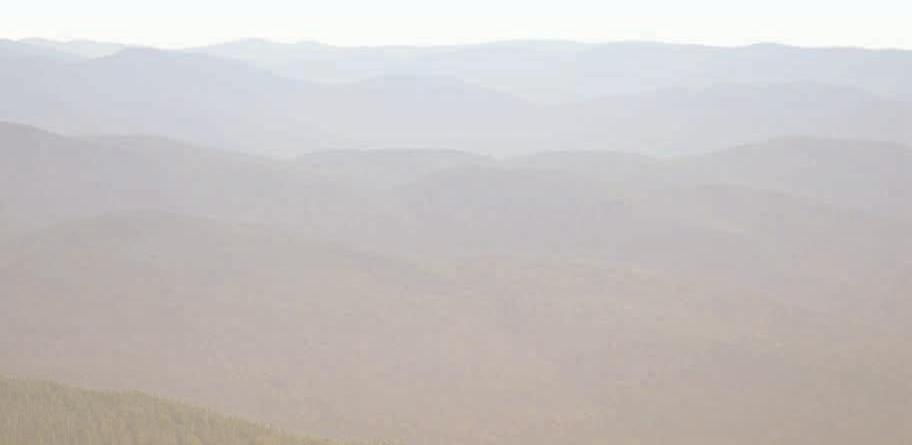



continued from page 2
ultimately, it’s worth it because I get to hang out with family more.
You’ve had a prolific career, not just in stand up, but as an actor and writer as well. I’m wondering if you could talk about how the writers’ and actors’ strikes have affected you.
It hasn’t affected me as much as it’s affected other folks who were working or had something they were going to do that got shut down, and, of course, all the attendant industries that are part and parcel of creating a TV show or making movie.
I just got very lucky on the timing in the sense that this tour was put together because there was something that Bob Odenkirk and I had written and sold and we were going to do for Paramount Plus, but then they decided not to do it. So, I was like, “Oh, s--t, well, now what do I do?” I had well over 50 percent of the material, enough to go out on the road, so I just concentrated on getting an hour and booking it.
So, I’ve been doing stand-up pretty much since the beginning of the year and started the tour in March. So, I know I’m going to be doing those shows, I know I’ve got an income coming, and I’m quite lucky in that respect that, just the timing of everything, I’m less affected than other folks who are just sent home.
Have you been in support, on the picket lines?
Oh, f--k yeah. Absolutely. This is incredibly important. It’s so egregious what (industry executives) want to do, it threatens the whole industry. And that’s not hyperbole,
NOISE
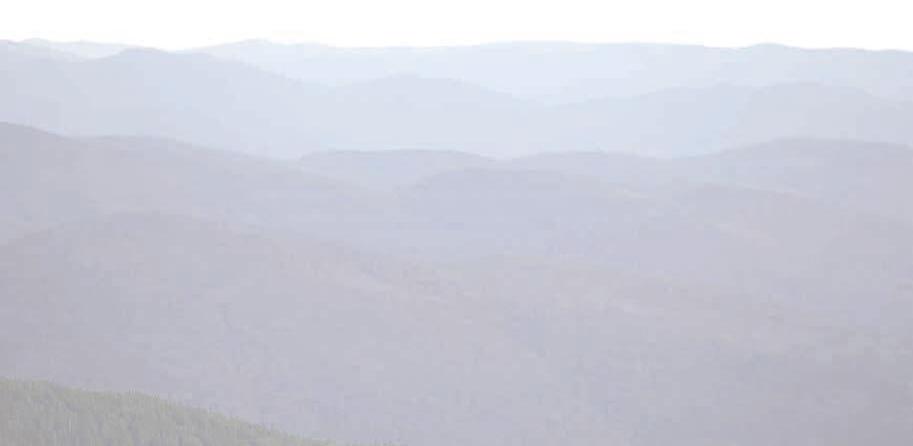

continued from page 1
board member Louise McCarren to facilitate a neighborhood conversation between the two groups with the hopes of mediation. However, McCarren, in a phone call, said she has not been a part of any sort of mediation efforts.
“I think the law is pretty clear that the shooting range has the right to be there,” she said. “I feel very badly for the neighbors.
that is absolutely not hyperbole, that is the truth.
I’ve read all of this stuff about keeping the rights to actors’ AI likeness and things like that —
F--k these people. F--k em’ hard. They’re just disgusting.
Disney’s CEO really added fuel to the fire with his comments.
But that comment isn’t like — that’s what they feel and that’s what they think. And their whole thing is like, “Oh, well, we’ll wait until they lose their apartments,” says the guy with nine multimillion-dollar properties and three yachts and the private airplane — we’ll wait until half the industry gets evicted and is living on the streets. That’s the plan. But again, that’s not a strategic, tactical thing to say. It’s what they believe, he just sort of slipped up and said it.
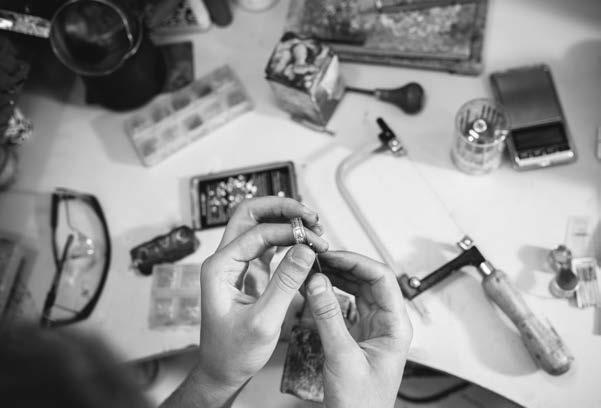
You’ve been vocal throughout your career on politics and your criticisms of both the Republican and Democratic Party and obviously Donald Trump. The writers’ and actors’ strikes, they’re just one of many popping up. What do you think is driving these strikes? And what does that say about our political reality here in 2023?

People are just getting fed up. It’s not like it was the status quo and then all of a sudden this popped up. This has been getting worse and worse for workers every single year, and every administration.


And then you see the frustration, understandably, that a lot of people have when Biden campaigns like “I’m going to be the first pro-union President since
FDR,” and he didn’t do s--t. Where is he on this?


And because the Democrats are funded, in great part, by all these Hollywood trillion-dollar behemoths — it’s yet another of the multiple examples of the Democrats just being beholden to moneyed interests, and, you know, making a big noise but not doing s--t.
He should be out there with the Starbucks workers who want to unionize. They’re working for a guy who declared for the presidency who is so anti-worker and anti-equity and has said as much. As you can tell I’m very strongly pro-union, I’ve benefited from it in multiple ways over the years. I wish my union was a little stronger, but it’s all step-by-step. What do you see as your role in politics and political activism as a comedian?
There’s always a role whatever you do. If you’re in the public arena and you make a statement that says, “I think Fascism is bad,” then obviously you’re influencing someone on some side. There’s a role to be played, but I don’t think it’s incumbent on anybody to play that role.

If you want to just do jokes that are about being a Jewish lesbian, do that, who cares. There’s a million really great comics out there who don’t do anything that’s remotely political that I love and I’m a fan of. I’m just talking about stuff that’s important to me, hopefully in a funny way, and if somebody likes it, if it influences somebody, great. If not, whatever.
But the way to deal with this, in my opinion, is to get everybody together. Let’s just talk about it.”

At the meeting, board member Lewis Mudge asked Faulkner whether the town’s attorney had warned the town about the risk of a potential lawsuit. Faulkner responded, “Yes,” but was quick to add, “I shouldn’t have even said that.”
Although the town has sought
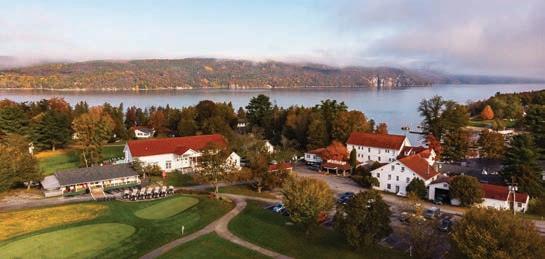
resolutions in the past, Faulkner suggested that the selectboard begin to consider crafting a noise ordinance for that area in order to evade any upcoming legal issues. McCarren was the only selectboard member quick to object to any noise ordinance aimed at the range.
“Everybody says you can’t do it, but the town’s running a risk,” Faulkner said.

Total Incidents: 55
Arrests: 2
Traffic stops: 28
Aug. 22 at 1:24 p.m., an officer assisted a resident in recovering a lost cell phone on Route 116.
Aug. 22 at 1:35 p.m., officers recovered a stolen vehicle out of Colchester on Route 116.
Aug. 23 at 8:30 a.m., police tried to stop a car for speeding on Shelburne Falls Road. The driver, a juvenile from Charlotte, was later charged with eluding police and gross negligent operation.
Aug. 23 at 11:51 a.m., officers investigated reports of suspicious activity in the area of Birchwood Drive.
Aug. 24 at 11:30 a.m., officers assisted a houseless family with securing resources.
Aug. 26 at 1:30 p.m., an individual was trespassed from a business on Route 116.
Aug. 27 at 7:30 a.m., an officer recovered a stolen car out of South Burlington on Hollow Road.
Aug. 27 at 11:00 a.m., officers responded to a domestic dispute on Mountain Spring Court. Michael Lavalette, 36 of Hinesburg, was arrested for domestic assault, interference with emergency services and a warrant for failure to appear in court. At the same time, Angel Robidoux, 24 of Hinesburg, was arrested for domestic assault.
Note: Charges filed by police are subject to review by the Chittenden County State’s Attorney Office and can be amended or dropped.
Gardeners can get their soils screened for lead at the Norwich Farmers Market on Sept. 9 from 9 a.m. to 1 p.m.
The screening is free, thanks to
ISSUE DATE: Thursday, September 7
Real Estate and BANG/Combination Ads are due Thursday, August 31, 5 p.m.
Display Ads and Classified Ads are due Friday, September 1, Noon.
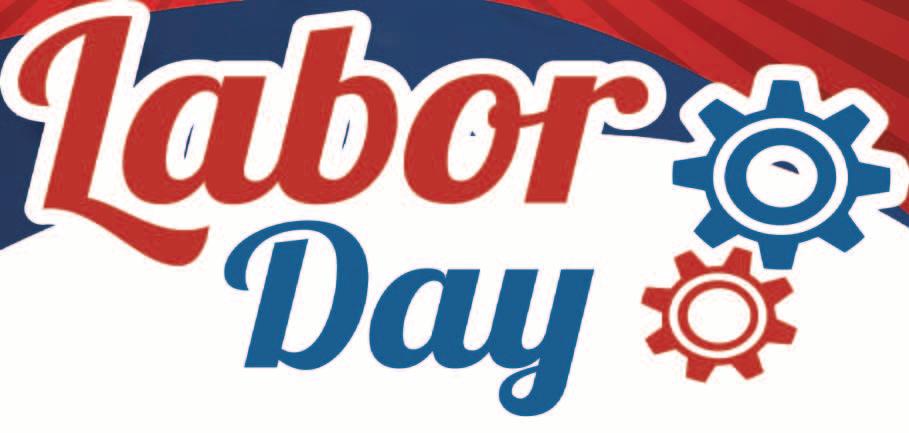
a partnership among the University of Vermont Extension Master Gardener program, Agency for Toxic Substances and Disease Registry and the U.S. Department of Agriculture Natural Resources Conservation Service.
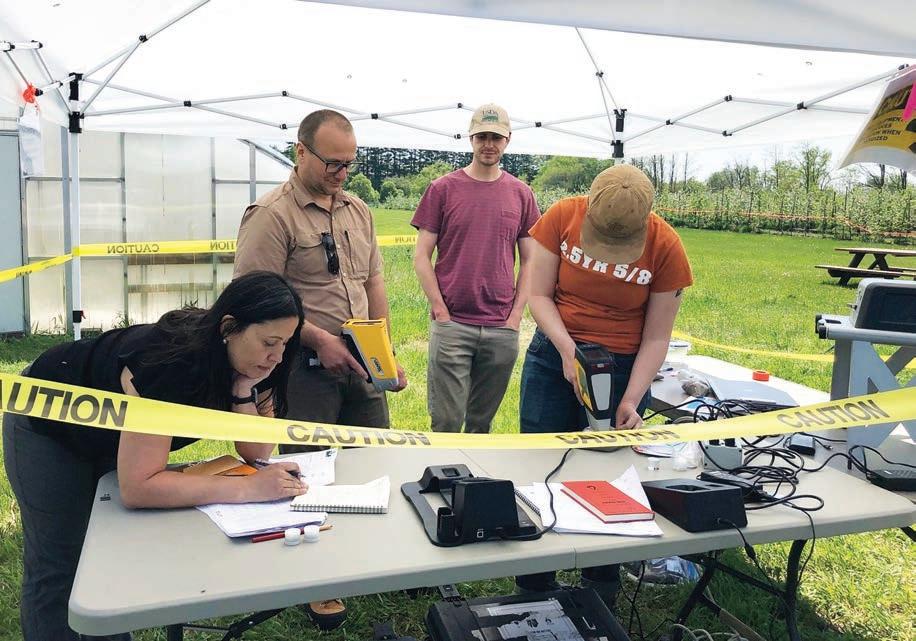
There is a limit of three samples
per person. Ornamental flower gardens do not need to be tested unless they include edible plants. Pre-registration is not required. Just bring your sample to the venue,
See LEAD on page 5
Serving the community of Charlotte & Hinesburg
A publication of Vermont Community Newspaper Group LLC thecitizenvt.com
Advertising Wendy Ewing wendy@shelburnenews.com (802) 985-3091 x12
Advertising Director Judy Kearns judy@otherpapersbvt.com (802) 864-6670 x21
News Editor Tommy Gardner
Staff Writers Aaron Calvin Corey McDonald Liberty Darr
Production Manager Stephanie Manning stephanie@shelburnenews.com
Editor/Publisher Gregory Popa gpopa@stowereporter.com
&
Billing inquiries Leslie Lafountain leslie@stowereporter.com (802) 253-2101
Advertising submission deadline: Friday at 5 p.m. advertising@thecitizenvt.com classifieds@thecitizenvt.com
Editorial submission deadline: Friday at 5 p.m. news@thecitizenvt.com

Calendar submission deadline: Friday at 12 p.m. news@thecitizenvt.com
Contact: 1340 Williston Road South Burlington, VT 05403 (802) 985-3091

The images of people in Maui fleeing toward the safety of the ocean as an apocalyptic, hurricane-driven firestorm bears down, unfolds like a horror movie as it becomes clear that losing a step or two might be the difference between life and agonizing death.
By all accounts this wildfire exploded like a bomb, speeding through Lahaina without warning — another vengeful environmental revolt, the latest in a series of climate hell-scapes heralding the arrival of this week’s new normal.
As the death toll exceeded 100 last Wednesday, and over 1,000 unaccounted for, officials expected the number to rise significantly as the grim task of sifting through tons of debris, much of it reduced to ash, searching for remains dragged slowly on. The recovery is tediously prolonged, becoming painfully apparent the same blast furnace heat that melted steel reduced bodies to brittle shells, so fragile they easily crumble, or even wisps of powder scattered ritualistically over the places they loved by Pacific breezes, as they might have been by distraught loved ones.
quickly. “We’re honored to have the president jump to it so fast. In six hours, he approved the presidential declaration (of disaster). It was incredible. Within six hours! And so that opened up FEMA and amazing support for recovery.”
Echoing Green, U.S. Sen. Brian Schatz said in a statement: “Recovering from these devastating fires will take significant time and resources and we need all the federal support we can get.”
Fire and water inexorably march through communities like a merciless, invading force bent on obliterating any illusions of safety we continue to harbor.
While the GOP’s sudden concern for human suffering might easily be dismissed as an exercise in the sleight of hand necessary to deflect attention from their likely presidential nominee’s deepening legal quagmire, far right politics does play a major role in the dangerous situation facing not only Hawaii but the rest of the nation and world as well.
Conservatives have propped up the fossil fuel industry for decades, profiting handsomely while suppressing any indication that petroleum products play a role in global warming, which Exxon Mobil knew more than 40 years ago would “lead to dramatic environmental effects by 2050.”
Capitalism left to its own devices rewards massive greed massively and the oil industry reflects perfectly how making money transcends all else, including human lives.
extensive devastation of the natural world.
The tar sands of northern Alberta are challenging to describe in size and scope; words feel insufficient and seem like an exaggeration. Imagine a gouged-out hole in a pristine boreal wilderness covering over 54,000 square miles, roughly the size of Florida, visible from space. The oil extraction project going on there for decades is a filthy degradation of the Earth where sludgy deposits of bitumen, mixed with sand, clay and water are eventually converted to usable, synthetic oil through a hugely expensive and environmentally disastrous process, leaving enormous loads of toxic waste as well as water and air pollution.
A riveting new book that reads like fiction but isn’t, John Vaillant takes us to the center of the tar sands, Fort McMurray, 600 miles north of the border, “an island of industry in an ocean of trees,” connecting, according to a Guardian review, “all those trees and that industry in an increasingly deadly symbiosis.”
In “Fire Weather: A True Story from a Hotter World,” the author outlines how one of McMurray’s byproducts is the very climate change that came home to roost in 2016 when a gigantic, fast-moving wildfire took the area by complete surprise, like the
fate suffered in Maui last week.
The same familiar circumstances were at play in the forests around Fort McMurray as in Hawaii: rising temperatures, dropping humidity and strong winds leading to fires of unusual intensity that caught officials unaware leading to the mass evacuation of nearly 100,000 people in Alberta and the desperate flight toward the sea in Lahaina. Created by climate change, according to Vaillant, these conditions have led to an atmosphere “more conducive to combustion than any time in the past 3 million years.”
The price the world pays for oil extends far beyond the gas pump. Previously safe places are no longer safe. Fire and water inexorably march through communities like a merciless, invading force bent on obliterating any illusions of safety we continue to harbor.
We’re no longer shocked by reports of blistering temperatures lasting for weeks on end, tropical downpours more likely in a monsoon, and the threat of rising tides, 100-degree ocean water and a planet at the tipping point.
The earth is screaming. Hopefully, someone is listening.
But even one of the worst tragedies of its type is not big enough to transcend American politics with theatrically aghast Republicans — who routinely write off thousands of gun deaths to “freedom” — quick to blame President Joe Biden for a mountain bike ride and time at a Delaware beach even as praise poured in for the White House’s rapid deployment of resources to the stricken island.
Hawaiian Gov. Josh Green thanked Biden for sending emergency relief so
LEAD
continued from page 4
located at 281 Rte. 5 South in Norwich.
Only one sample is needed from a large garden, but if you have multiple, edible gardens in different locations, you will need to sample these separately.
For a large area, collect soil from five to 10 random spots throughout the area. For small beds, choose three random spots.
Dig down 6-8 inches deep in each location for a soil sample, and then combine in a clean container. Remove any pebbles, roots or other debris.
Allow to air-dry. Do not use a hair dryer, oven or flame. Once dry, transfer 1-2 cups of the mixed soil into a clean one-quart zipper
As reported in The New Yorker, while gas prices soared last spring to well over $4 per gallon and people struggled to pay bills, Big Oil’s profits were through the roof, with major producers Exxon Mobil, Chevron and ConocoPhillips all earning, after taxes, profits of over $5 billion — and that’s only the first three months of the year. They don’t have anything against you personally, it’s just business. But as we are learning perhaps too late, the financial dividends of oil extraction are dwarfed by its
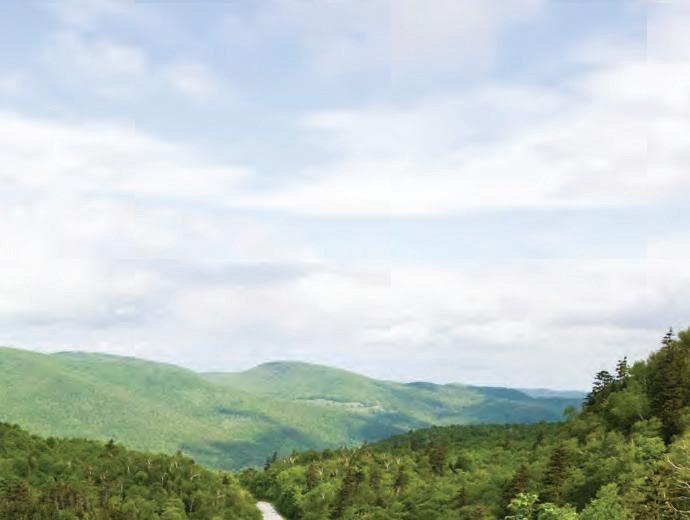


Sept.
or slider storage bag.
As a best practice, wear gloves when collecting soil samples. If collecting more than one sample, remember to rinse your shovel and container between samples. You will want to label each bag if multiple samples, so you know which test results apply to which area.
This event is sponsored by the Soil Screening, Health, Outreach and Partnership. Visit go.uvm.edu/gardensoilleadscreening to learn more about this event. For questions about soils, soil testing and gardening topics, contact the Master Gardener Helpline at go.uvm.edu/gardeninghelp.
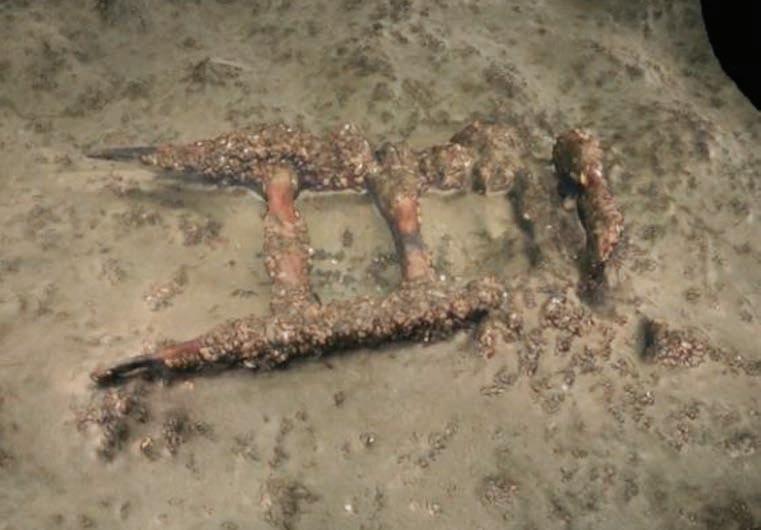
The historic rainfall and flooding in Vermont this summer have impacted people, businesses and watersheds, Lake Champlain included. While I’m grateful that Lake Champlain Maritime Museum exhibits and collections remain safe, I am keenly aware of the challenges the floods created for our staff and community, and the impact that flooding and other climate change events have on the lake, as well as the history underwater in Lake Champlain.
We’re dedicated to inspiring people to make personal connections to Lake Champlain through the region’s history, ecology and archeology. For the archaeology team, this work of making connections includes conducting ongoing archeological research, on land and underwater; caring for the collection of artifacts and research; and managing the lake’s underwater cultural resources and the Lake Champlain Underwater Historic Preserves, a unique system of shipwrecks in the lake open for divers to explore each May to October.
Flooding and ongoing climate change are threats to that work, the lake, and the lake’s shipwrecks and other underwater cultural resources.
Lake Champlain is a great historical record and research space for shipwrecks. Humans have been living around and traveling on Champlain for over 12,000 years. And the lake’s depth and location make it deep, dark and cold, which is the ideal environment for preserving shipwrecks. We estimate there are 200-300 shipwrecks in Lake Champlain, and they cover pretty much all eras of the lake’s history.
There are dugout or birch bark canoes from the Native American period; gunboats, galleys and transportation vessels from the military period; a wide variety of canal boats and steamboats from the commercial period; and sailing craft, rowing boats and other vessels from the present recreation period.
The Lake Champlain Basin, 8,234 square miles, encompasses all the waterways that are connected to the lake, and what happens in one affects the whole basin. So, what’s happening?
According to a 2020 report from the Nature Conservancy, the mean annual air temperature increased by 2.1 degrees Fahr-

enheit between 1967 and 2005, with most of those temperature increases happening during the winter months. As a result, the lake is freezing over less frequently and later each year. According to modeling from the Lake Champlain Basin Program, the lake freezes over about once every four years now, and researchers estimate that by 2050, the lake may freeze just once per decade. In addition, annual precipitation
has increased and there are more frequent intense storm events. As the Basin Program notes, heavy rainfall can affect water quality by causing erosion, flooding and sewer overflows that carry pathogens and sediments through tributaries and into the lake.
Lake Champlain Sea Grant predicts that annual average precipitation will continue to increase in the region, including more
extreme precipitation events that could increase the frequency and intensity of floods.
Flooding like we experienced last month causes runoff into the lake and increased siltation. Compare the two accompanying pictures of a hand truck at the shipwreck of the canal boat OJ Walker, located just outside of Burlington Harbor. On the left is a photo from the late 1980s and on the right from 2019.
In the image from the 1980s, you can see the two-wheel hand truck is sitting on the lake bottom surrounded by brick and drainage tile, which is what this ship was carrying when it sank. In the picture on the right, you can see all those details are obscured by the extensive siltation that’s happened in recent years.
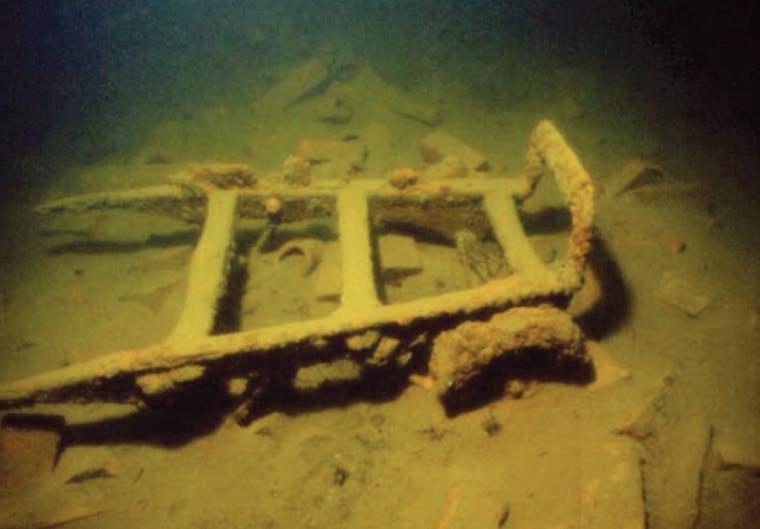
The hand truck is also obscured by globs of zebra mussels, an invasive species that will continue to spread as the lake keeps warming.
Siltation obscures history, access and complicates future research. And, most recently, it has prevented us from opening two of the dive sites in the Lake Champlain Underwater Historic Preserves as flood waters continue dumping silt and mud on the shipwreck sites of the Water Witch and the Diamond Island Stone Boat.
Warmer winters mean less ice and higher water temperatures, which creates a longer growing period for the summer biological activity, including the growth of invasive species and harmful cyanobacteria blooms. While invasive species have been infesting the lake since the 1800s, in 2020 there were 51 documented invasive species in Lake Champlain.
Among these invasives, zebra mussels are a significant threat to shipwrecks as they create these enormously thick colonies that coat the shipwrecks and their structures. Compare the two accompanying images below of an anchor before and after the arrival of zebra mussels.
Within these zebra mussel colonies, a sulfate-reducing bacteria begins to thrive, feeding on the iron components of shipwrecks. Over time the destruction of the iron and the tremendous weight of thousands of mussels can cause a shipwreck to collapse. And while Lake Champlain’s deep, cold water has protected deeper shipwrecks in the past — zebra mussels don’t like cold water and they have colonized
With every pair of Darn Tough & Smartwool socks sold, a pair will be donated to local non-profits serving the homeless.

John Klar, a lawyer and farmer from Brookfield, has just published “Small Farm Republic: Why Conservatives Must Embrace Local Agriculture, Reject Climate Alarmism, and Lead an Environmental Revival.”
ate and dangerous than any single-minded attack on fossil fuels to reduce global carbon dioxide emissions to stop global temperatures from increasing by another degree or two C by the end of the century.
While the subtitle is clearly intended to speak to conservatives, including libertarians and various types of decentralists across the political spectrum, those concerned about Vermont’s future who don’t consider themselves conservatives should read it nonetheless, because the path it charts offers a meeting ground for all but what Klar describes as “carbon cult doomsday advocates.”
Klar admits he was born in Connecticut but in his youth regularly stayed at his farm in Brookfield “where my (single parent) mother’s family had farmed for six generations until bulk tank and other unaffordable regulatory requirements drove them out.”
Klar was what one might call a trail hiking fanatic as he spent time hiking all over the U.S but especially in the White Mountains. He earned a law degree and practiced tax law in the United Kingdom and in Connecticut. In 1988 he was suddenly stricken with Lyme disease and fibromyalgia and could not continue his law practice.
He relocated with his wife Jackie, a “crazy horse person” and a nurse, to small, working dairy farms in Barton and Irasburg, and in 2019 removed to part of the maternal family homestead in Brookfield. That hands-on experience as a small farmer —dairy, pigs, produce, feed — sold Klar on the economic, cultural and political benefits of what he calls the “small farm republic.”
He became, in his words, an “agripublican.”
From his perspective, America faces an environmental challenge far more immedi-



“Local and regenerative farming practices reverse the climate and soil crises, reverse water depletion, and turn around the economic and cultural decline of rural communities. They reduce harms to human health from chemicals, preservatives, early harvesting (which deprives produce of vital nutrients), antibiotics, hormones, pathogens, nutrition deficiency and so on; lessen inhumane treatment of animals during life and slaughter, and mitigate negative consequences of globalization, including related threats to national security,” he writes.
“They also reduce American dependency on immense industrial producers and processors, ports, distributors, and retailers for food while building public trust in Republicans to offer sincere and effective solutions to observable environmental harms.”
He is a dedicated fan of cattle: “Ruminants comprise an integral link in sustainable agriculture and converting industrial meat production to rotational grass-based methodology is the best single tool to mitigate climate change.”
Klar doesn’t challenge the arguments for addressing climate issues, but he is scathingly critical of the Democrats’ solution of choice, the multi-trillion-dollar Green New Deal.
“The grotesque inadequacies, even counterproductive harms, proposer by the Green New Deal are apparent. Conservatives must lead the charge to fashion methods to counter the destructive profiteering that has dominated food production, and the deteriorating American environmental landscape, for over a hundred increasingly destructive years.”
In a paragraph that really ought to wake up liberals, Klar writes, “The ‘Green




Revolution’ was really about selling chemicals, agricultural machinery, and engineered seeds (and plunging farmers into destructive debt), and so is this climate-rescuing spin about peddling solar panels, EVs, and other technologies to which a handful of profiteers will make a quick bundle at the expense of true change.”
That’s certainly grist for a Michael Moore follow-on exposé to “Planet of the Humans.”
Can America, heavily urbanized, possibly revert to adequately feed itself through millions of environmentally sensitive small farms?
“Small Farm Republic” falls short of making a believable case for it. Nor does it explain how millions of people working in America’s vast food creation, processing
SABICK continued from page 6
the lake only to 100 feet below the surface. As water temperature increases each year, the mussels will be able to move into deeper water and colonize those previously protected wrecks.
Flooding events and climate change create unsafe conditions where we can’t get in the water as researchers or avocational divers. We lose direct access to our underwater historical resources.
When invasive species, siltation and floods erode, damage and obscure shipwrecks we also lose data, evidence and the ability to continue learning about our
and distribution system can find other ways to make a living. This former tax lawyer’s policy recommendations, aside from deregulating small farms, tend to resemble the subsidy-ridden, tax credit fueled Green New Deal turned upside down.
That said, Klar’s writing is well informed, lucid and passionate. If it opens the eyes of both conservatives and liberals to the problems inherent in mega-agriculture, his book will become a valuable and timely addition to the works of Wendell Berry and Joel Salatin, both inspirations and enthusiasts for the book.
John McClaughry writes for the Ethan Allen Institute. He was executive secretary of the Food and Agriculture Cabinet Council in the Reagan White House.
past. New generations of archaeologists, scientists and historians will not be able to help us uncover new information when the evidence is gone.

When we lose access and evidence, we also lose our sense of our place, identity and change. Connecting to our past helps us feel connected to our community in the present and plan for a better future for our community and lake. When evidence of the past no longer exists, what happens to those connections and our future?
Chris Sabick is interim co-director and director of research and archaeology at the Lake Champlain Maritime Museum.
America, heavily urbanized, possibly revert to adequately feed itself through millions of environmentally sensitive small farms?
The Burlington Garden Club is sponsoring a “lollapalooza” of a Yard Sale on Saturday, Sept. 16 from 8 a.m.-2 p.m. at the Faith United Methodist Church at 899 Dorset Street in South Burlington.
The proceeds will go to the club’s scholarship program for outstanding students in the slant and soil science department of the University of Vermont, as well as other community projects the club funds.


“Many of our members have donated some stunning items for the sale, including antiques, small appliances, cookware, small pieces of furniture, gorgeous vases, flowerpots and gardening tools, artwork, linens, dishes, lamps, some fabulous jewelry, and much more,” club co-president Linda Lane said.
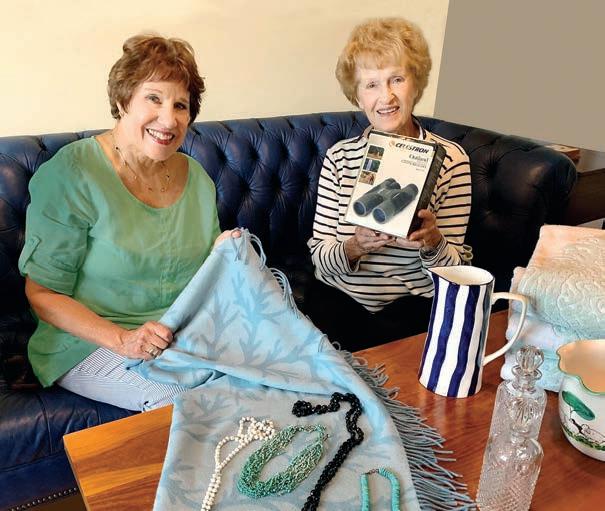
Additional information and photos of yard sale items are available on the Burlington Garden Club Facebook page. For more information, bgcvt.org.
Last month garden club members around Vermont donated (and collected donations of) hundreds of planters and fresh plants, which members planted and drove to Barre to offer to local businesses which had lost all their potted plants in the flooding and debris.
Other Vermont garden clubs are digging in to do their part
with their dedication to sustaining national and urban forests. The clubs raise donations from club members to replant disaster-struck forests.
The clubs work in partnership with the National Garden Club and the US Department of Agriculture. The project began in 1941 as a conservation project.
Doris Van Mullen, president of Federated Garden Clubs of
Vermont, states the “Penny for Pines” conservation effort entails planting replacement seedlings (not only pine trees) that are indigenous to forested areas damaged by insects, fires, or national catastrophes. The plantations provide soil and watershed protection, soil stabilization, as well as beauty and shade for recreation. To learn more, gardenclub.org/ penny-pines.
The Age Well meal pickup for Thursday, Aug. 31, is from 10-11 a.m., Charlotte Senior Center, 212 Ferry Rd., and features pork loin with sauce, mashed potatoes, spinach, wheat biscuit, apple cake, and milk.
You must have pre-registered by the prior Monday at 802-4256345 or meals@charlotteseniorcentervt.org
The meal on Thursday, Sept. 7, features chicken marsala with mushroom sauce, diced potatoes, peas and onions, potato roll with butter, pumpkin Craisin cookie and milk.
The suggested donation is $5. Check the website for last-minute cancellations at charlotteseniorcentervt.org.
Want to start a compost pile, but not sure how to start?
Consider signing up for the online Vermont Master Composter course, which starts Sept. 1. The course will run for eight weeks with all course materials available to participants until November 16.
You will learn the basics of backyard composting, including
site and bin selection, “recipes” to make healthy compost and tips for keeping rodents, bears and other animals out of your compost. The course also will cover the biology of composting, the decomposition process and Vermont’s Universal Recycling Law (Act 148).
The registration fee is $50 for Vermonters and $150 for out-ofstate residents and includes all materials. You can register at https://go.uvm.edu/mastercomposter. The deadline is Aug. 31.
You have a choice of two tracks. The at-your-pace track allows you to view the modules at your own convenience.
If you want to become a certified Vermont Master Composter to teach people in your community how to become better composters, then sign up for the volunteer track. This track includes live discussion sessions with instructors offered through Zoom on Thursdays from 6-7:30 p.m., beginning Sept. 7. You also will have the opportunity to attend in-person workshops to see community composting in action.
To become a Vermont Master Composter volunteer, you must commit to a minimum of 10 hours, providing education and service around small-scale composting. To fulfill these volunteer hours, you may give presentations at local libraries, schools and other nonprofits or work with school and community composting projects around the state.
If you live out of state or are not interested in the volunteer component, you may take the online course at your leisure and earn a Backyard Composter Certificate of Completion.
The course is sponsored by the University of Vermont Extension Community Horticulture Program with financial support from the Vermont Agency of Natural Resources.
For more information or to request a disability-related accommodation to participate, contact Deb Heleba at debra.heleba@ uvm.edu or (802) 656-1777.
Shop local and please remember our advertisers!
Ackermann Dairy, a 120-head organic dairy farm in Hardwick, has been named the 2023 Vermont Dairy Farm of the Year.
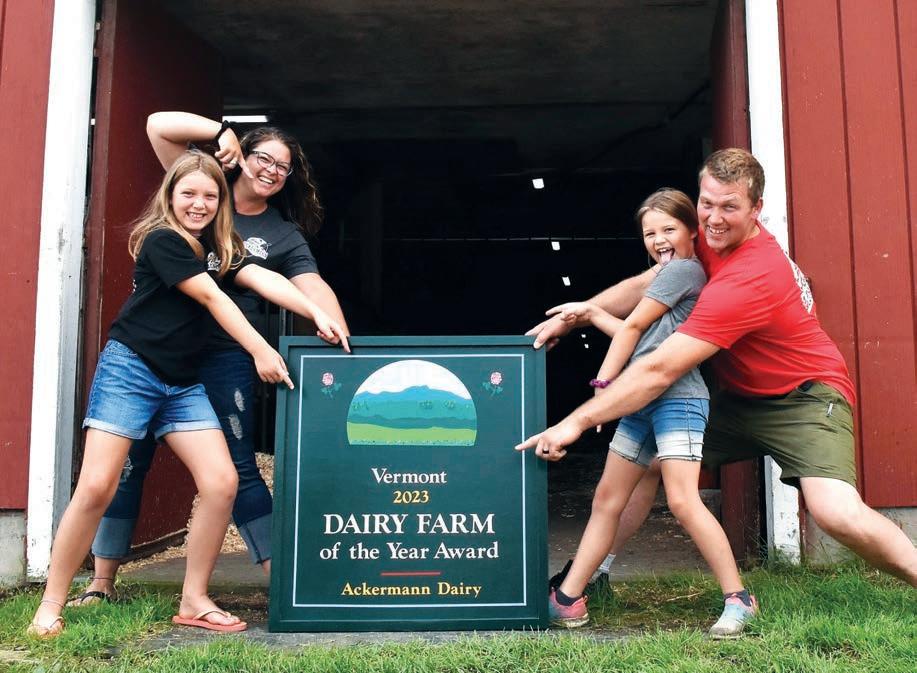
Jimmy and Sara Ackermann have been farming for 16 years, including nine at their current location. They were recognized by University of Vermont Extension and the Vermont Dairy Industry Association with this award for their overall excellence in dairying, including their efficient and sustainable farm management, outstanding herd and high-quality milk production.
They currently milk 60 to 65 Holsteins twice daily in a tie stall barn with four units. Their rolling herd average is 22,600 pounds with 4.1 percent butterfat and 3.1 to 3.2 percent protein. In 2022, they began shipping their milk to Stonyfield Organic and have already earned several quality milk awards.
The Ackermanns plan to switch to robotic milkers within the next two years, a move that will allow them to grow their milking herd to 80, a size that falls within their goals to stay sustainable and on budget. They’ll breed for teat length and square, even udders, characteristics that work better for robotic milkers.
They raise all their own replacements, breeding their heifers to calve at 24 months with cows bred back at 60 days fresh. Calves are fed colostrum within a few hours of birth, then water at
Elinor Lucia, 88, of Hinesburg, died peacefully on Oct. 1, 2022, at her home surrounded by family.
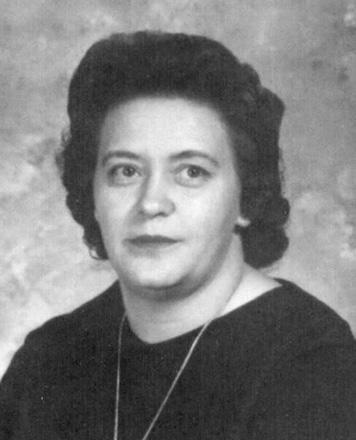
She is survived by sisters Mary Brace and Helen Cote; brothers, Henry Emmons and Francis Emmons; children, Marylou LeBoeuf, Earl Pecor, Carol Gooley and Kelley Lucia; stepdaughter, Joanne Choiniere; eight grandchildren and several great grandchildren.
She was predeceased by her husband, Charles Lucia.
Elinor had a love for animals, gardening and cooking. She enjoyed bringing family and friends together to share a meal. She was always ready to lend a hand to anyone in need.
One of her proudest accomplishments was returning to high school as an adult and earning her diploma. Her strong determined spirit will be
three days. They get calf starter and dry hay at one week old, then waste milk for two months, which the farmers believe gives them a head start when they are weaned.
They grow enough grass to supply all their own forage needs with surplus to sell some years. Most years they get four cuts of hay from their 300 acres of owned and leased land, yielding an average of three tons per acre of haylage.
Cows are fed a total mixed ration of silage and dry hay. They pasture their animals at night in warmer weather, bringing them in during the day, the opposite of what most farmers do. They feel that it’s more comfortable for them outside at night as it is cooler with fewer flies.
Future plans include building a new free-stall barn with separate areas for the calves, cows and heifers to house them all under one roof. Although it will be built on the footprint of the existing 1940s-era barn, its design will allow for enhanced cow comfort, something that the Ackermanns say is critical to the health and contentment of the cows, which in turn, results in higher milk production.
Other finalists for this year’s award were Liberty Hill Farm (Kennett Family), Rochester; Lucky Hill Farms (Henry and Jennifer McReynolds), Danville; and Skyline Holsteins (Sheena Brown), Derby.
SCHOOL continued from page 1
Valley School District, which includes Hinesburg, Charlotte, Shelburne, Williston, and St. George, is facing a budget hole that will either need to be raised through a 16 percent homestead tax rate increase, or by dramatically cutting spending in the district.
“We have been an advantaged district under the old formula. That’s no longer going to be the case,” Marckres said. “We will be disadvantaged by the new weights, and if we want to maintain our current level of per pupil spending, we will really be forced to raise tax rates.”
The timing couldn’t be any worse for facilities work. The district’s school buildings are aging and are in need of investments due to both capacity issues as well as their age.
“They have been well maintained,” Marckres said. “But the fact is they’re getting older, and they need work.”
a good hard look and do some careful planning and look at every aspect of how we use our facilities, how they’re organized and maintained, and what they need.”
The administration will soon create a larger facility study committee — including board members, faculty and staff and other stakeholders from the broader community — as a starting point for a capital plan.
“This will cost money and I don’t know if we can find an offset for this,” he said. “But a full-blown facilities and capital planning visioning study for a district this size is probably a quarter million dollars that we would be looking at spending over the long term to actually get the info to have an informed capital plan that’s supported.”
during the meeting they would begin requiring offsetting reductions for any new expenses. School board members asked whether there was a way to lobby the state legislature on the impacts the district faces.
“Is there any way to fight this? Is there an error in the formula or an error in the assumption and is there a way to change the assumption... or impact upon (the legislature),” school board member David Connery asked.
Board chair, and House Rep. Angela Arsenault, said there’s a conversation in the Statehouse on the negative impacts faced by these school districts noting there are several school board members in the Legislature “disadvantaged districts”
missed. A graveside service will be held on Saturday, Sept. 9, 2023, 11:30 a.m. at Holy Rosary Cemetery in Richmond, with a reception following at Our Lady of the Holy Rosary Hall in Richmond.
In lieu of flowers contributions can be made to Our Lady of the Holy Rosary Church or the bishop’s fund.
A draft architectural study for Hinesburg’s Community Study, recently received by the district, shows there is significant work to be made to the community school. Next up is Champlain Valley Union High School, which Marckres said hasn’t had an architectural study done in 20 years.
“It’s not all doom and gloom. Our facilities are safe and useable,” he said. “But they won’t stay that way forever, so we’ll have to take
The new education formula signed into law last year provides for a cap of 5 percent per year through fiscal year 2029 to ensure tax increases are not overly onerous.
School administration officials hopes to use the next five years, while the cap is still in place, to identify resources “that don’t align with our goals in the strategic plan or have become inefficient of obsolete,” Marckres said. Replacing transportation fleets with electric vehicles, for example, and working on other capital improvements.
Administration officials said
“There are conversations already happening — it will probably take legislative action,” Arsenault said. “I don’t get the sense that it was fully thought through what that difference would be (for well-resourced districts) and what it would mean to the tax rate to make up that difference.”
Marckres noted, however, that the effects of Act 127 are not immediate.
“It’s important to point out that we do have time,” he said. “Unless there’s further legislative action on this topic, we have five years to prepare. And I think that’s important to remember.”
Local businesses and restaurants need your support more than ever. Whether you visit stores, get delivery or shop online, keep your spending local and keep your community healthy.
Newspapers are LOCAL. We are dedicated to keeping you informed, safe and connected and care about the issues that are important to our neighbors, our schools and our businesses.
Local businesses and restaurants need your support more than ever. Whether you visit stores, get delivery or shop online, keep your spending local and keep your community healthy.
When you support your local newspaper, you support your community.
Newspapers are LOCAL. We are dedicated to keeping you informed, safe and connected and care about the issues that are important to our neighbors, our schools and our businesses.
From May to October, thousands of hikers tromp rocky trails lined by tiny cotton thread on the exposed summit of Mansfield, the highest point in Vermont. The mountain is home to a variety of complex ecological landscapes, each determined by elevation and climate.
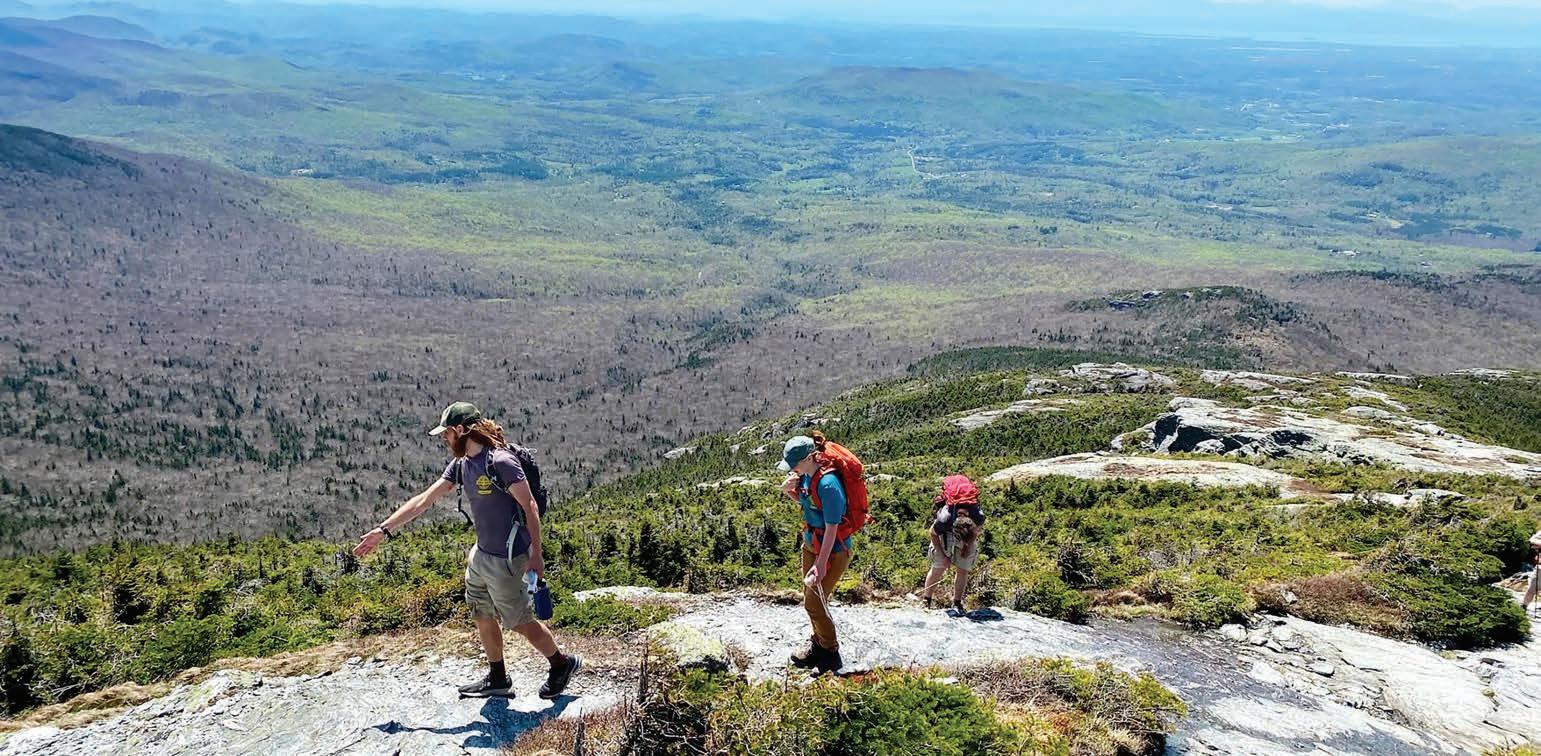
When taking up an expedition toward the summit, hikers enter a lush green forest dominated by beech and maple trees. They scramble up rocky trails decorated by ferns and mosses and tunneled by foliage.
rarity of the species themselves, but by the unique collections of life and geological conditions that, together in their assemblage, are rare, according to Grace Glynn, a Vermont Fish and Wildlife Department botanist.
The vegetation in this alpine meadow has been forming for more than 3,000 years and, in areas, has peat 4-feet deep, she said. Mansfield supports the largest expanse of alpine meadow in the state.
Mansfield is located on the northern half of the spine of the Green Mountains and peaks at 4,393 feet above sea level, according to the Department of Forests, Parks and Recreation.
tain ranges because of the type of bedrock it is made of, Glynn said. The stone weathers into soil that’s very acidic, which directly influences plant communities.
The plants on the summit already handle a lot of abuse from high winds, ice needles and trampling by hikers. The Green Mountain Club patrols the summit above treeline to prevent people from degrading the alpine vegetation, according to the club’s Volunteer Coordinator Kate Songer.
But on a larger scale, over the next couple decades, the outlook for those unique alpine populations is bleak, Rebozo said.
When you support your local newspaper, you support your community.
Then the forest gradually transitions into an array of hardy conifers, the needles of which change the composition of the soil and overhaul the scenery entirely. Near the summit, stunted balsam fir, black spruce, red spruce and heart-leafed paper birch emerge. These trees are dwarf in height, whipped by wind and built to endure below-freezing temperatures.
Unlike surrounding mountain ranges such as the White Mountains and the Adirondack High Peaks — which have several densely located high-elevation summits — Mansfield is isolated in its height from surrounding areas, according to Ryan Rebozo, director of Conservation Science at the Vermont Center for Ecostudies.
Researchers anticipate Vermont will become warmer and wetter as climate change progresses. This change in climate will likely cause low-elevation plants to creep toward higher ground and encroach the territory that alpine shrubs currently dominate, so the forest transitions people see as they hike the mountain will likely change, he said.
Contact Wendy Ewing at wendy@shelburnenews.com or 985-3091
TODAY
At the top of the mountain, only shrubbish vegetation can persevere.
This area is an alpine meadow, and it is what biologists call a “rare natural community.” These communities are defined not by the
This makes Mansfield a sort of island refuge for high-elevation species, Glynn said. It is home to a number of natural communities, some of which are rare or endangered.
Additionally, Mansfield is unique from surrounding moun-
As torrential rains flooded much of the state in mid-July, on the mountain, the rain mainly affected trails and the auto road that switchbacks up the mountain, according to Rebozo.
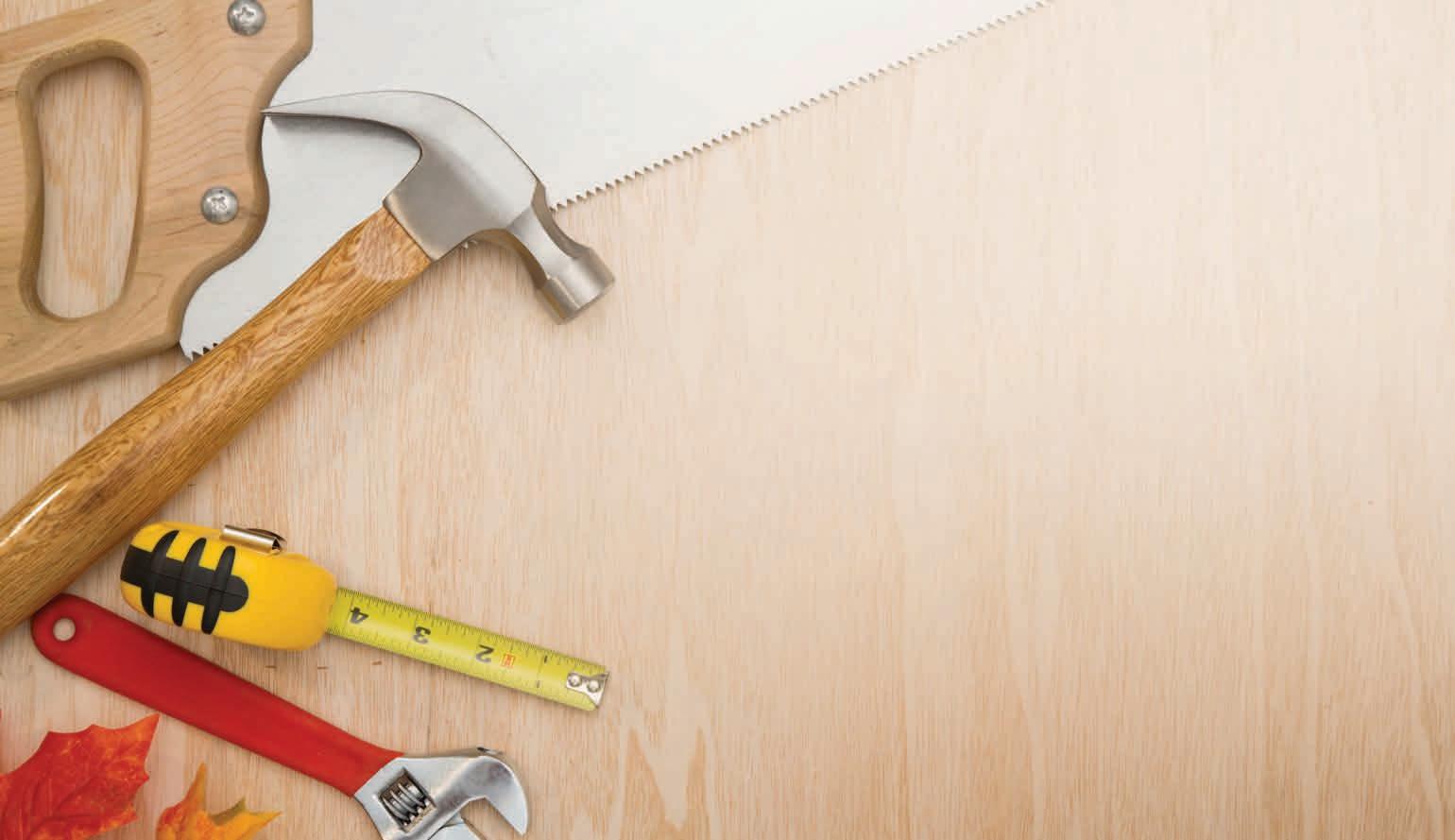
Some of my favorite forest managers are landowners, people who work on a small scale to make their forests a little heathier and more vibrant each year. While a thoughtful forest steward can have a truly positive relationship with their woods, the breadth of their impact is limited by their finite time and energy. Through using these five simple techniques, you can maximize the positive impact that you have on your forest.
Leave dead trees alone. Fallen trees, dead-standing trees and dead wood benefit wildlife habitat, soil health and fertility, carbon storage and forest hydrology, among other things. If the tree is dead, leave it alone! Be proactive, not reactive: focus on cutting living trees, especially unhealthy trees which are competing with healthier “crop trees.”
Use the “crop tree release” method, a shift in the way that we look at the forest: instead of focusing on cutting all the trees that “need to go” — trees that are unhealthy, that have wounds or defects, trees of undesired species — we find our forest’s healthiest, most promising trees and release them from competition individually.
“Crop tree” is a bit of a misnomer: while a crop tree could be a tree that we’re encouraging to produce a crop like maple sap, it can also be any healthy tree of almost any species. What makes crop tree release so efficient is that we only cut trees that are

competing with our crop trees. If a tree isn’t competing with a crop tree, leave it alone. Get comfortable with cutting trees and leaving them on the ground. This will be a more efficient use of your time — allowing you to release more crop trees and thus have a greater positive impact on your woods — and will also increase the amount of dead wood in your forest and its associated habitats and benefits.
Girdle some trees. “Girdling” a tree means creating two shallow, parallel cuts around its circumference, just deep enough to touch its wood. This severs the tree’s cambium, eventually killing the tree and turning it into a “snag” (a dead-standing tree), which is another important habitat. Girdling will turn trees into hazards, so it’s not a method to be used around your house or your recreational trails.
Get comfortable with “messiness.” In working with hundreds of landowners, I find that nearly everyone’s instincts tell them that a healthy, well-managed forest looks like a park: with large, evenly spaced trees and a clear, open understory.
In fact, healthy forests are messy, with trees of all different sizes and ages, dead trees, gaps in the canopy and tons of dead wood on the forest floor. “Cleaning-up” our forests — removing dead trees and dead wood, managing them to look like parks — is not just a waste of time: it actually makes our forests less healthy, less resilient and less rich with habitat. When you manage your forest, avoid piling brush or lopping up trees and branches so that they lie flat
on the ground. While they make your forest look neater, these practices actually diminish many of the benefits that these trees and tree tops offer to wildlife and forest ecology. If you can learn to appreciate the messiness, you’ll see that not “cleaning-up” your forest will save you tons of time and energy, and
make your forest healthier at the same time.

Ethan Tapper is the Chittenden County Forester for the Vermont Dept. of Forests, Parks and Recreation. See what he’s been up to, check out his YouTube channel, sign up for his eNews and read articles he’s written at linktr.ee/ChittendenCountyForester.
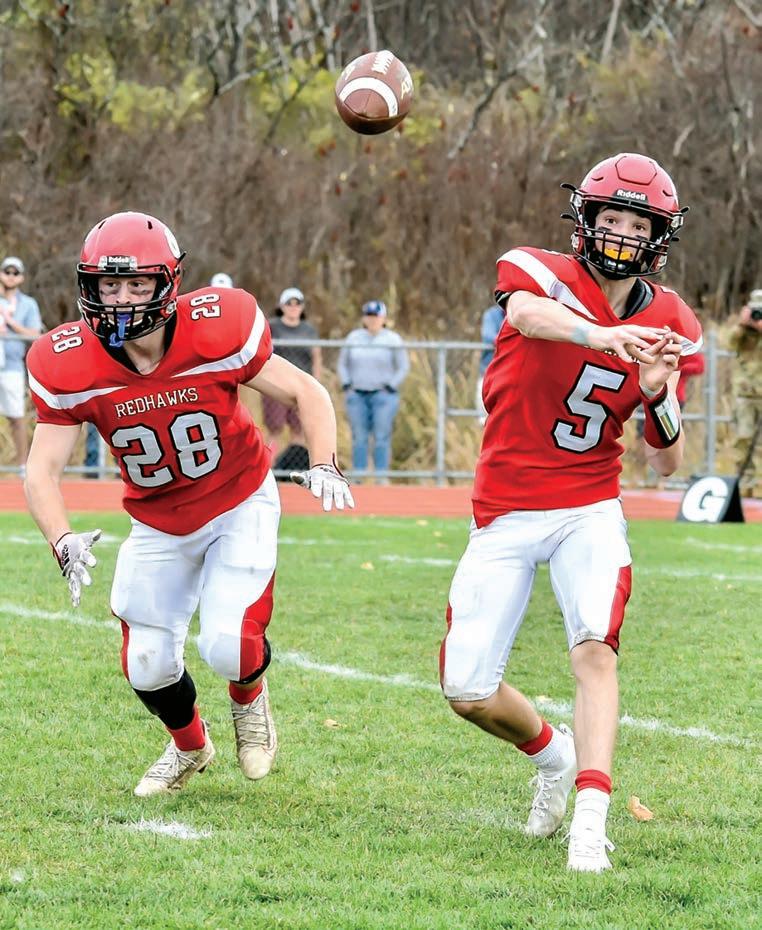
Champlain Valley Union High School is no stranger to state titles, and the Redhawks have raised their share of trophies over the years. Last year, though, CVU marked some milestone moments.
The CVU girls soccer team captured the program’s 20th state title, making it the winningest soccer program in state history. The Redhawks field hockey team celebrated its first title in nearly 15 years. And the CVU football team won the program’s first-ever Division I state championship.
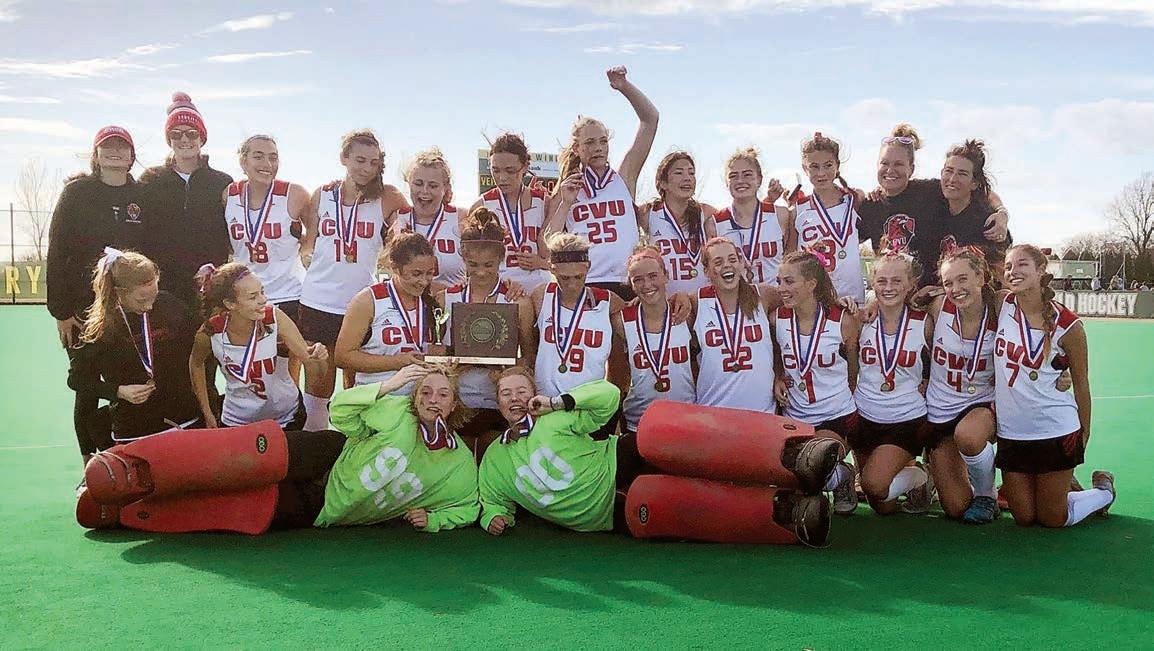
After a year holding the top spots, now these three Champlain Valley teams turn their focus to defending their titles.

It took an overtime period over rival South Burlington, but last year finally saw Champlain Valley break through to win the Division I title for the first time in 14 years. Now the Redhawks must turn their attention to the defense of their trophy.
They will have some work to do early in the season to figure out how to replace players that graduated after last season, including Miranda Oppenheimer, who scored the OT winner in the final, Tess Everett in the midfield and Danielle Gamelin on defense.
But CVU does have an experienced roster with five seniors and 10 juniors, so the defending champs will hope to keep the growing pains to a minimum. The Redhawks will look to senior Emily Gay and Claire Marcoe to produce on offense, while Cordelia Thomas will look to take over in the midfield as a sophomore.
Champlain Valley will open their season on Wednesday, Sept. 6, against Essex at 4 p.m.
While the other two CVU title winners are on somewhat new ground, the Redhawks girls soccer team is very familiar with the position in which they find themselves this fall.
After capturing the program’s 20th state

title last year, the Redhawks are now in the hunt for No. 21 and they will do so with a very experienced group.
The team returns Chloe Pecor, the Burlington Free Press player of the year, Ava Barron anchoring the midfield and Stella Dooley steadying the defense. All in all, the Redhawks return 16 players from last year’s squad.
The team did face some early season struggles as weather and poor field conditions made it hard to get a full preseason outside so the hope is that the rain holds off as the regular season gets underway so the team can find their feet outside.
The girls’ soccer season starts Friday,

Hart & Mead Energy and All Star Fuels in Hinesburg/Bristol area is looking for an individual with a clean CDL-B / Hazmat endorsement. Able to pass federally mandated drug screeening. DOT physical required. Competitive wage, paid holidays and sick time.

Contact hartmeadllc@gmail.com or 802-482-6666

Sept. 1, at Mount Anthony. Kickoff is 4 p.m.
Football
Champlain Valley finished last season in new territory, as Division I football champions. Now they start this season off in even more unfamiliar territory, as defending champs and the No. 1 team to beat.
The Redhawks will look to some key returning players to set the tone early, including quarterback Ollie Cheer, running back Jacob Bose and wide receivers Brian Rutherford and Jacob Armstrong, which should give the team some early chemistry on offense.
But CVU will need some time
to find replacements for departed players, most notably Gatorade Player of the Year Alex Provost. And they will have to do it quick, as the Redhawks start the season off against another team expected to contend, Burr and Burton.
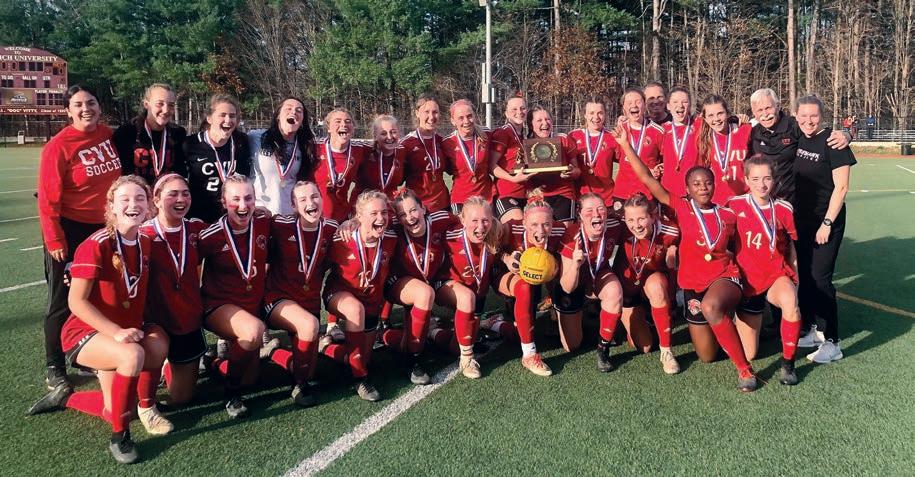
Champlain Valley opens its title defense on Saturday on the road at Burr and Burton at 1 p.m.
Shade Tree Preservation Plan Public Hearing
September 12, 7:00 - 8:30 p.m.
Charlotte Town Hall
The features and merits of Charlotte’s draft Shade Tree Preservation Plan will be presented and discussed.
For more information, including a Zoom link, see the Tree Warden section of the town website, or the following links:
https://bit.ly/Charlotte_STTP_overview and https://bit.ly/Charlotte_draft_STTP
Democratic voters of the Town of Hinesburg, County of Chittenden, are hereby notified in accordance with 17 V.S.A. Section 2303, to meet in caucus on Tuesday September 12, 2023 at 7:00 pm in the courtyard outside the Town Clerk’s office, 10632 Route 116. The agenda will be the election of Hinesburg Democratic Committee members, officers, delegates to the Chittenden County Democratic Committee, and any new business.
Bring a folding chair if you want.
Any registered voter in Hinesburg, who has not participated in the caucus process of another political party, is invited to attend.
Ernest “Bud” Allen, Town Democratic Chair Gill Coates, Town Democratic Committee Secretary/Treasurer
The roads are overflowing with peepers looking for great shopping, things to see and do, and places to dine in or take out. Let us help you reach the tens of thousands of visitors who come to play in the mountains surrounding Stowe, Cambridge and Morrisville and to explore the gorgeous Lake Champlain Valley and beyond.
continued from page 2
The week-long bait drop is a coopera tive effort between Vermont and the U.S. Department of Agriculture Wildlife Services to stop the spread of the potentially fatal disease.
saliva. If left untreated, rabies is almost al ways fatal in humans and animals. However, treatment with the rabies vaccine is nearly 100 percent effective when given soon after
So far this year, 23 animals in Vermont have tested positive for rabies, and 14 of
According to wildlife officials, rabid animals often show a change in their nor mal behavior, but you cannot tell whether an animal has rabies simply by looking at it. People should not touch or pick up wild
RABIES BAIT
Rabies is a deadly viral disease of the brain that infects mammals. It is most often seen in raccoons, skunks, foxes, and bats, but unvaccinated pets and livestock can also get rabies.The virus is spread through the bite of an infected animal or contact with its
continued from page 2
The week-long bait drop is a cooperative effort between Vermont and the U.S. Department of Agriculture Wildlife Services to stop the spread of the potentially fatal disease.
Rabies is a deadly viral disease of the brain that infects mammals. It is most often seen in raccoons, skunks, foxes, and bats, but unvaccinated pets and livestock can also get rabies.The virus is spread through the bite of an infected animal or contact with its
saliva. If left untreated, rabies is almost al ways fatal in humans and animals. However, treatment with the rabies vaccine is nearly 100 percent effective when given soon after a person is bitten by a rabid animal.
So far this year, 23 animals in Vermont have tested positive for rabies, and 14 of those have been raccoons.
Porches
Outdoor Structures
802-343-4820
www.pleasantvalleyvt.com
Bob & Jessica Trautwine
Cell/Txt: 802-233-1451 • O ce: 802-497-1681

According to wildlife officials, rabid animals often show a change in their normal behavior, but you cannot tell whether an animal has rabies simply by looking at it. People should not touch or pick up wild animals or strays – even baby animals.
continued from page 4 face burne-Hinesburg head the Golf depending land. Rotary’s
Shelburne Historical Society will have a display and president Dorothea Penar will lead a cemetery tour at 1 p.m. Food vendors round out the event with everything from coffee and lemonade to burgers and creemees. Kids will enjoy meeting animals from Shelburne Farms, craft projects, and
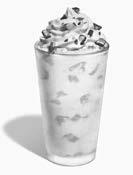
SHELBURNE DAY
continued from page 4 face burne-Hinesburg head the Golf depending land. Rotary’s
Shelburne Historical Society will have a display and president Dorothea Penar will lead a cemetery tour at 1 p.m. Food ven dors round out the event with everything from coffee and lemonade to burgers and creemees. Kids will enjoy meeting animals from Shelburne Farms, craft projects, and
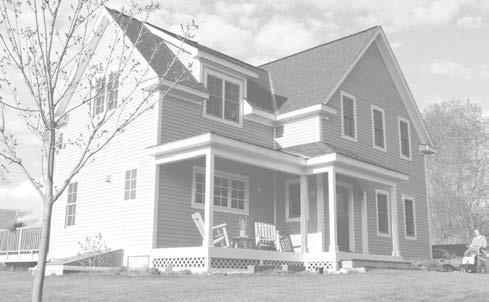









•
for rates: call 985-3091 or email advertising@shelburnenews.com

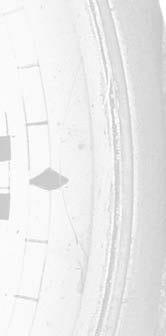





Spring Cleanup & Mulch
Roofing
Lawn Maintenance
Siding
Renovations
Landscape Design
Stonework & Planting
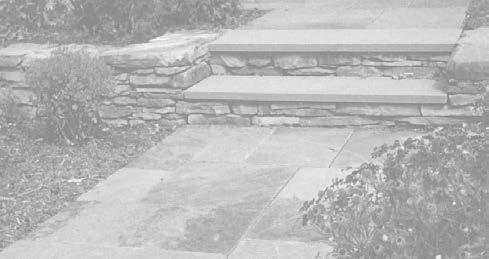
Mini Excavation
Painting Decks
802-343-4820
802-343-4820
www.pleasantvalleyvt.com
March 21 - April 20
Aries, you may want to move your relationship in a different direction, but your partner is resistant. This could be a con ict, or something that opens up a dialogue.
April 21 - May 21
Taurus, you might feel like doing all you can to make a problem go away, and think that acting immediately is the way to go. But ponder a few options beforehand.
May 22 - June 21
Gemini, a professional opportunity that seems to have many positive nancial outcomes actually could have a down side to it. It’s best if you do your research before acting.
June 22 - July 22
You may think that others do not understand you, Cancer. But that may be a good thing. You can focus on explaining your position and maybe make a few friends along the way.
July 23 - Aug. 23
Leo, you tend to be attracted to things that tempt fate or may even be considered forbidden. When others want you to walk the straight and narrow for a bit, it could be tough.
Aug. 24 - Sept. 22
Virgo, an opportunity to get away presents itself. Enjoy this much-needed respite and don’t he afraid to go the extra mile to ensure the trip is as memorable as possible.
Sept. 23 - Oct. 23
You may want to do it all, Libra, but sometimes you have to let others know you have limits. When you don’t, it is easy to get taken advantage of or run yourself ragged.
Oct. 24 - Nov. 22
Scorpio, are you ready for an adventure? Identify some new hobbies and then learn all you can about getting out there and doing those types of activities with frequency.
Sudoku puzzles are formatted as a 9x9 grid, broken down into nine 3x3 boxes. To solve a sudoku, the numbers 1 through 9 must ll each row, column and box. Each number can appear only once in each row, column and box. You can gure out the order in which the numbers will appear by using the numeric clues already provided in the boxes. The more numbers you name, the easier it gets to solve the puzzle!
Nov. 23 - Dec. 21
A loved one may want to be more cozy with you this week, but you’re content to have ample space and do your own thing, Sagittarius. Let your views be heard on this situation.
Dec. 22 - Jan. 20
Capricorn, you may want to tell a loved one what they want to hear right now to make a dif cult situation go away. However, that only postpones the inevitable tough talk.
Jan. 21 - Feb. 18
You have been feeling like it is time to break away from your regular routine, Aquarius. It could be because there has been added stress on your shoulders. A vacation may be needed.
Feb. 19 - March 20
There are some limits to doing all of the work on your own, Pisces. First off, you may lack the time and the expertise. Bring on helpers this week if anyone is available.
CLUES ACROSS
1. Midway between east and southeast
4. At right angles to a ship’s length
9. William Penn’s business partner
14. __ de plume
15. Accomplished soccer coach
16. Bone cavities
17. __ juris: independent





18. Popular Philly sandwich
20. Northern Ireland county
22. Performing artist
23. S S S
24. Lacks avor
28. Commercials
29. Anno Domini (in the year of Our Lord)
30. Qatar’s capital
31. Indigenous peoples of Alberta
33. Popular footwear
37. Indicates position

38. Anglican cathedral
39. Aircraft part


41. Before
42. Blood group
43. Secretory organ
44 .Fencing swords
46. The small projection of a mammary gland
49. Technological
advancement
50. Male parent
51. Dissociable
55. More cold
58. Cape Verde Islands capital

59. Blood disorder
60. Creative
64. Sun up in New York
65. Made angry
66. Relieves
67. Brooklyn hoopster
68. Seasonsings
69. Movable barriers
70. Attempt
CLUES DOWN
1. Occur as a result of
2. Spiritual essences
3. Representative
4. Entering
5. Nobel Prize-winning physicist
6. Midway between northeast and east
7. Consumed
8. Tablelands
9. Kids’ craft accessory
10. Not known
11. Sound directed through two or more speakers
12. A major division of geological time
13. Wild ox
19. Shock treatment
21. Turner and Lasso are two
24. Genus of owering plants
25. Relating to ductless glands
26. Stock certi cate
27. Satis es
31. Places to enjoy a rest
32. Edward __, author and writer
34. “__ but goodie”

35. One hundredth of a liter
36. Shabbiness
40. TV personality Roker
41. Triangular upper part of a building
45. Speed at which you move
47. Offend
48. A reference point to shoot at
52. Forays

53. Biblical city
54. Blatted
56. Northern sea duck



57. Shabby (slang) 59. Allege 60. Tax collector 61. Whereabouts unknown 62. Chinese philosophical principle 63. Indicates equal

MANSFIELD


continued from page 10
The rest of the mountainside remained more or less unphased by this summer’s storms, as places with vegetation generally hold soil better. But long-term, continued storm patterns will have major impacts, he said.
“The storm is an indication of change,” he said. “It’s one piece of this bigger puzzle of all these stressors to survive. It’s the temperature. It’s the water. It’s the high elevation. It’s everything else.”
Researchers expect a resettling of flora and fauna, he said. Roadside weeds, for example, have already begun to creep up to areas closer to the summit.
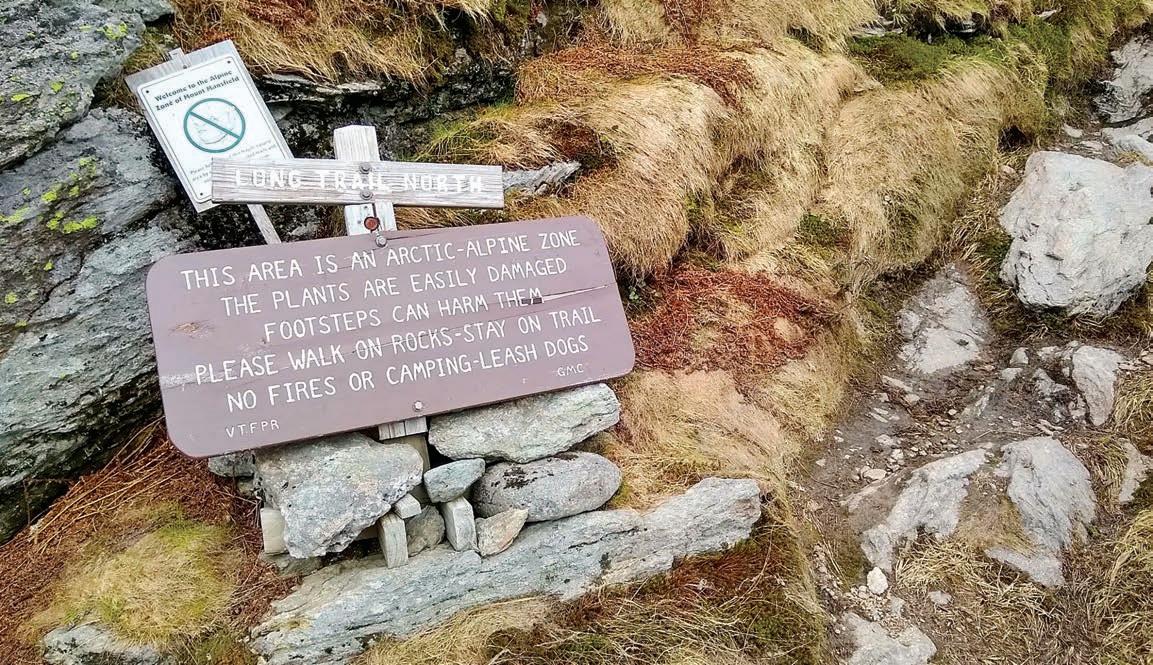
But the bulk of change is predicted to take several decades due to the germination cycle of plants. If winters shorten and warm, the plants will experience a longer growing season. This will cause hardwood trees to compete with conifer trees, he said.

This expanse will, as a result, threaten the high-elevation communities, closing in on one of the last places they can exist. Many of the species on Mansfield’s summit are already endangered, including the white flowered diapensia or the waxy-leafed bearberry willow.
A movement upward from low-elevation plants would affect birdlife as well, causing them to breed higher up, Rebozo said. This would again impact endangered birds, such as the Bicknell Thrush, which have historically always had a place in Vermont.
“We’re already starting to see pretty striking declines on some of these high-el-
evation breeding birds,” Rebozo said. “On places like Mansfield, we’re getting what used to be lower-elevation breeding birds showing up closer to the summit.”
The Bicknell Thrush is a migratory bird that travels from the Caribbean up to Mans-
field each year. Its biggest threats are climate change and habitat quality, he said. They are a point of concern because both of their residencies are threatened, as storms also become more frequent and more severe in the Caribbean.
With more research yet to be done, Rebozo said the Vermont Center of Ecosystem intends to focus on insect research on Mansfield to understand the link between animals, bugs and vegetation in the ecosystems that live there.